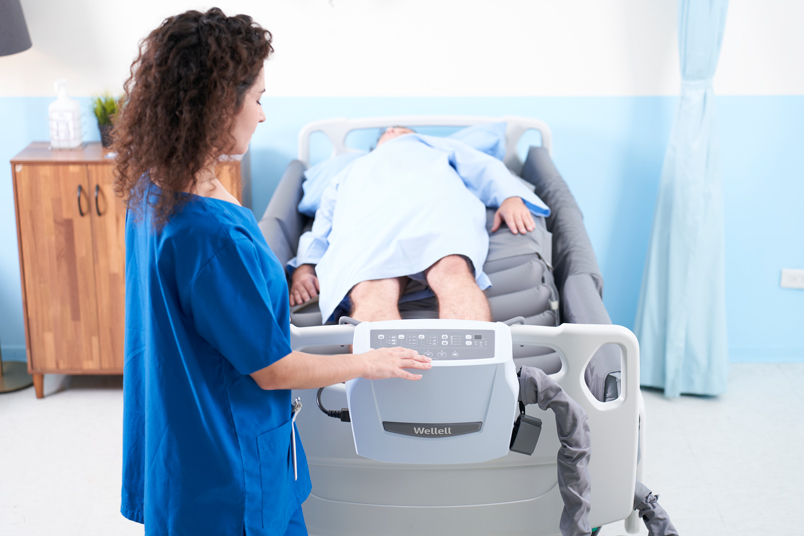Optimize workflow and pressure injury prevention: automate 30° lateral turning
There are up to 44% of in-hospital patients end up developing pressure injuries. The mortality rates from pressure injuries are 2 to 6 times as much as from other diseases, with 60,000 deaths annually due to this complication according to NIH. Also, pressure ulcers are the third most costly disease after cancers and cardiovascular diseases.1 Factors that increase the risk of developing pressure injuries include patient's condition such as mobility, sensory perception, obesity, diabetes, nutrition, and perfusion; also environmental factors such as pressure, shear force & friction, heat buildup, and moisture.2 It is crucial to implement proper pressure injury intervention devices such as pressure reducing / redistribution mattress systems to mitigate pressure injury risks, and determine customized therapies including turning procedures based on the guideline and individual patient’s pressure injury risk assessment result.
Regularly turning patients to 30° lateral position reduces the incidence of pressure ulcers
The risk of pressure injuries increases when immobile individuals are unable to turn or move voluntarily. Repositioning critically ill patients requires careful consideration and planning. EPUAP/NPUAP/PPPIA guideline recommends that turning patients regularly to the 30° lateral position reduces the incidence of pressure injury compared with usual care (90° lateral position). People who were positioned in a 90° side-lying position were 3.7 times more likely to experience pressure injury than those who were positioned in a 30° side-lying position. It is encouraged to sleep in a 20° to 30° side-lying position or flat in bed if not contraindicated for individuals who can change their own position. In critically ill patients who do not tolerate increment turns, repositioning strategies that should be implemented include weight shifts, passive range of motion, repositioning of extremities, head rotation, heel floating, and lower angle turns. Using these methods should be based on individual tolerance.2

Figure: setting up 30° lateral turning position.
Repositioning every 2 to 4 hours is widely accepted
EPUAP/NPUAP/PPPIA guideline also recommends determining the patient's level of activity and their ability to reposition themselves to guide health professionals' decision‐making in terms of the frequency and amount of assistance they provide to patients in repositioning. There is no clear evidence regarding which particular positions and repositioning frequencies are the most effective for preventing pressure injuries in adults.2 Changing in body position every 2 to 4 hours is widely accepted as a provisional guideline for best practice.3
Optima Turn optimizes care delivery process by providing automate workflow, it automatically redistributes pressure for different patient contours and improves full-body pressure relief care and comfort through better immersion and envelopment. Caregivers can implement automated turning cycles with customizable frequencies (10, 20, 30 or 60 minutes) and angles (10, 20 or 30 degrees). This significantly reduces time and cost of wound care in hospitals. In addition, automated turn feature significantly reduces complexity of patient turn procedure and nursing workload with minimal manual intervention, this is very helpful especially in critical care environment.
**Discover our range of pressure relief mattresses
References
1. Afzali Borojeny, L., Albatineh, A. N., Hasanpour Dehkordi, A., & Ghanei Gheshlagh, R. (2020). The Incidence of Pressure Ulcers and its Associations in Different Wards of the Hospital: A Systematic Review and Meta-Analysis. International journal of preventive medicine, 11, 171. https://doi.org/10.4103/ijpvm.IJPVM_182_19
2. National Pressure Injury Advisory Panel. (2019, March 13). Pressure Injury Prevention--Repositioning Frequency. Npiap.com. https://npiap.com/store/viewproduct.aspx?id=14123202
3. Schindler, C. A., Mikhailov, T. A., Kuhn, E. M., Christopher, J., Conway, P., Ridling, D., Scott, A. M., & Simpson, V. S. (2011). Protecting fragile skin: nursing interventions to decrease development of pressure ulcers in pediatric intensive care. American journal of critical care : an official publication, American Association of Critical-Care Nurses, 20(1), 26–35. https://doi.org/10.4037/ajcc2011754
- Related Article:
Repositioning Patients to Prevent Pressure Injuries

